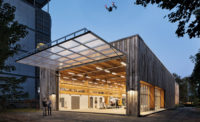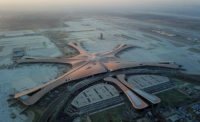It’s time for architects to take embodied energy more seriously—the total sum of energy used to extract, manufacture, transport, and assemble materials for building—as Columbia’s David Benjamin and Harvard’s Kiel Moe make clear in their respective books on the topic. The way we design today results in buildings that consume more energy than ever before, with serious consequences. According to Benjamin and Moe, architects egregiously approach buildings as isolated objects when they are instead moving parts in a far-reaching, enduring, and complex network.
Embodied energy is difficult to calculate, especially since most metrics are insufficient; the nuanced set of conditions that govern how we build, such as the quality of human labor or the state of global trade, must also be weighed if we are to build sustainably. But, as Benjamin, founding principal of the Living, writes in Embodied Energy and Design, these aspects are outside what is normally evaluated; the insights in this book of essays bring some to light. An essay by GSAPP colleague Jorge Otero-Pailos, for instance, contemplates the influence of cultural values, writing that they “charge our relationships to architectural objects with a cultural energy that we then reify as cultural capital.”
Essays ponder the various trajectories of building; some even put forth solutions for curbing negative externalities: Mason White, professor of architecture at the University of Toronto, discusses how the geographic sources of material extraction, labor, and fuel are all part of architecture’s expanded territory; Stephanie Carlisle, environmental researcher at KieranTimberlake, suggests that design decisions be guided by rigorous material life-cycle analysis to track environmental impacts.
The stories told in Embodied Energy attempt to make sense of the overwhelming scales and intricacies involved. For example, a series of “material stories” advocates simple inquiries (i.e., which cities have steel unions?) for improving efficiency along the supply chain; Daniel Barber, professor at the University of Pennsylvania School of Design, takes a broader view, linking global energy flows to geopolitical events surrounding World War II.
Somewhat similarly, Moe, also a contributor to Benjamin’s book, chronicles embodied energy as a product of time in Empire, State & Building. Part manifesto, part history, it plots the 200-year development of the Empire State Building parcel in New York, from farmland to rowhouses, mansions, and skyscraper, illustrating how a single city block’s embodied energy is tied to patterns of urbanization. He uses archival documents, and occasional wisdom from philosophers such as Henri Lefebvre and Michel Foucault, to look at how energy and material flux within each cycle of construction and deconstruction advanced the parcel to its next phase.
The iconic skyscraper lends each term of its name for the book’s three parts: “Empire,” or geographic reach of materials; “State,” or set of relative thermodynamic, political, and socioeconomic conditions; and “Building,” or urbanization processes, involved in the various incarnations of the site. As one might suspect, each successive building embodied more energy than its predecessor. But the skyscraper’s speedy construction (just over one year), its density, and its steady occupancy, among other factors, have resulted in net efficacy as an ecological system. It may be even more efficient, suggests Moe, than a comparably sized net zero tower constructed with advanced materials and up-to-date systems, which, ironically, require astronomical amounts of energy to produce and install.
Moe’s book successfully navigates the relationships of energy, time, and space in an easily digestible format—but lacking is a compelling account of what’s at stake if we continue to build per the status quo; this is where Embodied Energy and Design is particularly useful. If there’s one crucial takeaway from both texts, it’s that architecture must be designed as a holistic system. Considered together, the books serve as a vital provocation to architects to reconsider their capacities as agents of urbanization.









Post a comment to this article
Report Abusive Comment